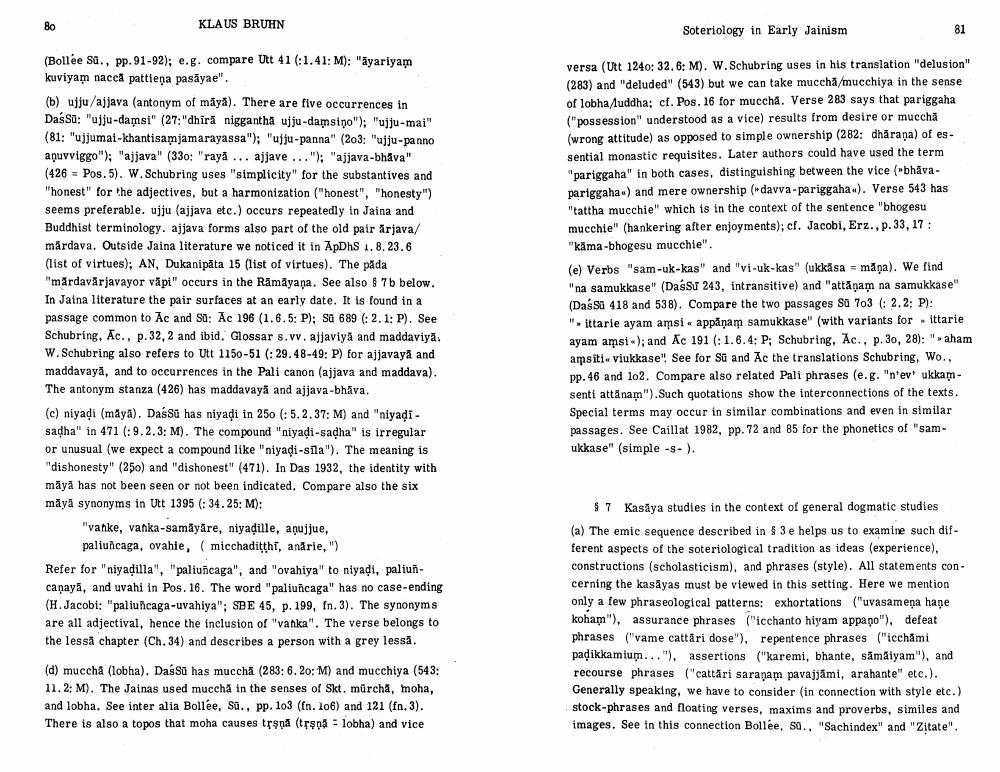________________
KLAUS BRUHN
Soteriology in Early Jainism
(Bollée sa., pp. 91-92); e.g. compare Utt 41 (01.41: M): "İyariyam kuviyam naccă pattieņa pasāyae". (b) ujju/ajjava (antonym of māyā). There are five occurrences in Dassa: "ujju-damsi" (27:"dhira niggantha ujju-damsino"); "ujju-mai"
81: "ujjumai-khantisamjamarayassa"); "ujju-panna" (203: "ujju-panno aņuvviggo"); "ajjava" (330: "raya ... ajjave ..."); "ajjava-bhāva" (426 Pos. 5). W. Schubring uses "simplicity" for the substantives and "honest" for the adjectives, but a harmonization ("honest", "honesty") seems preferable. ujju (ajjava etc.) occurs repeatedly in Jaina and Buddhist terminology. ajjava forms also part of the old pair arjava/ mārdava. Outside Jaina literature we noticed it in ApDhs 1.8.23.6 (list of virtues); AN, Dukanipāta 15 (list of virtues). The pada "mārdavārjavayor vāpi" occurs in the Rāmāyaṇa. See also $ 7b below. In Jaina literature the pair surfaces at an early date. It is found in a passage common to Ac and Sa: Ac 196 (1.6.5: P); Sa 689 : 2.1: P). See Schubring. Ac., p.32, 2 and ibid. Glossar s.v.ajjaviya and maddaviya. W. Schubring also refers to Utt 1150-51 (:29.48-49: P) for ajjavaya and maddavaya, and to occurrences in the Pali canon (ajjava and maddava). The antonym stanza (426) has maddavaya and ajjava-bhava. (c) niyadi (māyā). Dassu has niyadi in 250 (:5.2.37: M) and "niyadi - sadha" in 471 (: 9.2.3: M). The compound "niyadi-sadha" is irregular or unusual (we expect a compound like "niyadi-sala"). The meaning is "dishonesty" (250) and "dishonest" (471). In Das 1932, the identity with māya has not been seen or not been indicated. Compare also the six māyā synonyms in Utt 1395 (: 34.25: M):
"vanke, vanka-samāyāre, niyadille, asujjue,
paliuncaga, ovahie, (micchadithi, anārie, ") Refer for "niyadilla", "paliuncaga", and "ovahiya" to niyadi, paliuncaņayā, and uvahi in Pos. 16. The word "paliuncaga" has no case-ending (H. Jacobi: "paliuncaga-uvahiya"; SDE 45, p. 199, fn. 3). The synonyms are all adjectival, hence the inclusion of "vanka". The verse belongs to the lessä сhapter (Ch. 34) and describes a person with a grey lessā.
versa (Utt 1240: 32.6: M). W. Schubring uses in his translation "delusion" (283) and "deluded" (543) but we can take muccha/mucchiya in the sense of lobha Auddha; cf. Pos. 16 for muccha. Verse 283 says that pariggaha ("possession" understood as a vice) results from desire or muccha (wrong attitude) as opposed to simple ownership (282: dharana) of essential monastic requisites. Later authors could have used the term "pariggaha" in both cases, distinguishing between the vice (-bhavapariggaha) and mere ownership (davva-pariggaha.). Verse 543 has "tattha mucchie" which is in the context of the sentence "bhogesu mucchie" (hankering after enjoyments); cf. Jacobi, Erz., p.33, 17: "kāma-bhogesu mucchie". (e) Verbs "sam-uk-kas" and "vi-uk-kas" (ukkasa - māņa). We find "na samukkase" (Dassu 243, intransitive) and "attāņam na samukkase" (Dassa 418 and 538). Compare the two passages Su 703 (: 2.2: P): "ittarle ayam amsi. appāņam samukkase" (with variants for ittarie ayam amst-); and Ac 191 (: 1.6.4: P: Schubring. Ac., p. 30, 28): ", aham amsiti, viukkase" See for SQ and Ac the translations Schubring, Wo.. pp. 46 and 102. Compare also related Pali phrases (e.g. "n'ev ukkamsenti attanam"). Such quotations show the interconnections of the texts. Special terms may occur in similar combinations and even in similar passages. See Caillat 1982, pp. 72 and 85 for the phonetics of "samukkase" (simple -5- ).
$7 Kasāya studies in the context of general dogmatic studies (a) The emic sequence described in $3 e helps us to examine such different aspects of the soteriological tradition as ideas (experience), constructions (scholasticism), and phrases (style). All statements concerning the kasāyas must be viewed in this setting. Here we mention only a few phraseological patterns: exhortations ("uvasameņa haņe koham"), assurance phrases ("icchanto hiyam appaņo"), defeat phrases ("vame cattāri dose"), repentence phrases ("icchami padikkamium..."). assertions ("karemi, bhante, sāmãiyam"), and recourse phrases ("cattāri saranam pavajjāmi, arahante" etc.). Generally speaking, we have to consider (in connection with style etc.) stock-phrases and floating verses, maxims and proverbs, similes and images. See in this connection Bollée, so.. "Sachindex" and "Zitate".
(d) muccha (lobha). Dassa has muccha (283: 6.20: M) and mucchiya (543: 11.2: M). The Jainas used muccha in the senses of Skt. mūrcha, moha, and lobha. See inter alia Bollée, Sa., pp. 103 (n. 106) and 121 (fn. 3). There is also a topos that moha causes trsna (tropa - lobha) and vice




